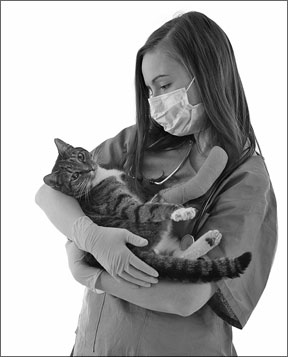If your cat steps on broken glass, catches his dew claw in the carpet or has his ear bitten in a catfight, expect blood to flow. Witnessing any of these scenarios can be jarring, but at times like these you need to know the steps to slow or stop the bleeding and take your cat to the nearest veterinary clinic. You have an emergency on your hands.

288
“A laceration of a large artery or vein could lead to life-threatening bleeding in minutes,” says Daniel J. Fletcher, DVM, Ph.D., Assistant Professor of emergency and critical care at the Cornell University College of Veterinary Medicine.
The likelihood of a cat’s “bleeding out” depends on how quickly he’s treated and the type of bleeding that has occurred. The three types are:
– Arterial, characterized by spurting, bright red blood.
– Venous, characterized by a slower flow of dark-red blood.
– Capillary, characterized by superficial blood oozing, as could occur from a nick in the tip of the ear.
“After a 15 percent blood loss, a cat can begin to have difficulty compensating for it and will start to exhibit an increased heart rate and decreased blood flow to core organs like the heart and brain,” Dr. Fletcher says. “Once a cat has lost more than 30 percent of blood volume, he begins to develop serious shock.”
Feline nylon muzzles are available at pet supply stores. The muzzle fits over the face, covering the eyes, and fastens at the back of the neck with Velcro. A small opening at the nose enables breathing.
Condition your cat to being fitted with the muzzle at peak training motivational times, such as right before meal time. Be calm and reward him with praise and a small treat. “If your cat is bleeding from a laceration, he is likely to be in pain and even the sweetest family pet may bite if he is in pain, so it is best to be cautious and use a muzzle,” Dr. Fletcher says.
Use Sterile Gauze. The next step: Apply direct pressure on the wound by using sterile gauze pads from a first-aid kit. “If no sterile gauze is available, a clean towel, T-shirt or any clean fabric available will work,” says Dr. Fletcher.
If blood saturates the first layer of gauze or clothing, apply another clean layer on top and apply direct pressure. Do not remove the first layer because the blood is clotting. You may need to apply several layers and direct pressure to slow or stop the bleeding. Then wrap roll gauze or fabric at least two to three times around the wound and secure it with medical tape. Be careful to make the wrap snug but not so tight that it will cut off circulation.
You can transport your cat to the veterinary clinic in a carrier or wrap him in a large bath towel, which may require some previous practice. Make sure his claws are tucked inside the towel to prevent your being scratched or bitten. Do not attempt to scruff your cat — that is, grasping the loose skin on the top of his neck. Cats have flexible spines and can pivot their back feet and scratch you.
Alert the Clinic. As soon as possible, call the nearest veterinary clinic to let the staff know you’re on your way so they can prepare a room for your cat. Ideally, have a family member or friend drive while you limit your cat’s movements inside a large towel or, ideally, placed securely inside a pet carrier. Monitor him for signs of shock. “They include pale gums, a fast heart rate and weak pulses,” says Dr. Fletcher. “However, even animals without these signs are at high risk of life-threatening complications and should be seen by a veterinarian as soon as possible.”
Depending on the severity of the injury, your cat may be given pain medication and stitches. He may require follow-up visits for new wound dressings.
Although you may be vigilant in pet-proofing your home and do your best to keep your cat safe, you can’t completely protect him from harm. But you can be prepared to handle an emergency by taking pet first-aid classes. They’re designed to give you hands-on training to stabilize, immobilize and safely transport your injured pet to a clinic. To locate a class in your area, ask your veterinarian or local animal shelter to suggest a qualified first-aid instructor.



